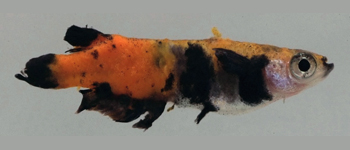Melanoma molecular genetics
(Manfred Schartl, Kang Du, Mateo Garcia Olazabal, Petra Fischer, Irene da Cruz)
Malignant melanoma is one of the most dangerous tumors with an incidence rising faster than any type of cancer worldwide. Small aquarium fish, like medaka (Oryzias latipes) and different Xiphophorus species, offer valuable model systems for this disease and can be used to study melanoma initiation and progression.
Molecular mechanisms underlying melanoma development in Xiphophorus
In Xiphophorus, the development of naturally occurring melanomas can be initiated by simple crossings, which lead to a pigment cell specific overexpression of Xmrk, a mutationally activated EGF-receptor tyrosine kinase. In order to understand the molecular processes underlying the melanoma-initiating overexpression, we use Next Generation Sequencing (NGS) based approaches (RNA-seq, ATAC-seq and methylome sequencing) as well as cell and molecular biology techniques, including expression pattern analyses and structural and functional promoter studies. Moreover, the development of a mitfa:xmrk transgenic medaka line allows us to perform in vivo studies on transgenic and CRISPR/Cas9 knock-out models. We are also interested in characterizing the role of several tumor modifier candidate genes and perform validation of candidate genes detected in our fish models with established cell culture systems of human melanoma research.
Search for novel melanoma-associated genes
Our goal is to identify global melanoma associated gene expression signatures by comparing RNA expression profiles of different melanoma samples from medaka and Xiphophorus. Once identified, these signatures will be used to search for new therapeutic agents for melanoma therapy.
Search for novel macromelanophore pigmentation genes
In our fish models melanoma develop from macromelanphores, a pigment cell type homologous to the nevus cells that make up the moles of humans. We compare macromelanophores and melanoma cells in Xiphophorus and medaka to identify the molecular program for differentiation of the benign precursor cells and the changes leading to malignancy. Another route for finding macromelanophore determining genes is provided by the Black Amazon pedigrees (Evolution of sexual reproduction) which also have macromelanophores and develop melanoma at old age. Here the conspicuous phenotype is contributed by a microchromosome, which is studied for its gene content.










